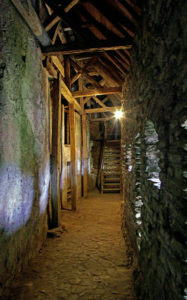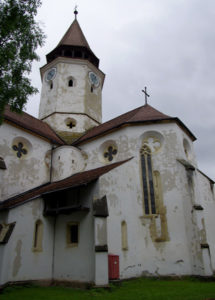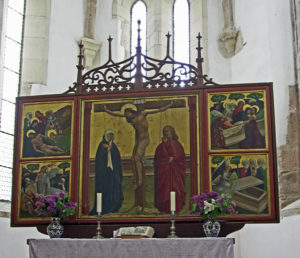Prejmer is a small settlement about eleven miles north east of Brasov. It is an attractive town with wide tree lined streets and a modern Orthodox church.
The area was settled in the early C13th by the Teutonic knights who built a church here. They stayed for about thirty years before they were banished by the Hungarians. In the C15th, the Hungarians invited the Saxons to settle and help defend the borders agains increasing attacks by Tatars, Turks, Mongols, Cossacks and Moldavians. They were responsible for fortifying the church in the C15th.
This is one of the best “fortified churches”:https://en.wikipedia.org/wiki/Prejmer_fortified_church#/media/File:Biserica_fortificata_din_Prejmer_v1.jpg in Romania. As it was the furthest east it was at the forefront of attacks. The village was destroyed over fifty times in raids, but the church was only captured once when the inhabitants ran out of drinking water. It was last used in 1783.
As well as the defensive wall around the church there is a defensive barbican in front of the entrance. A long arched passageway was added in front of this in the C17th with two sets of gates. A moat would have surrounded everything.
The walls are 12m high and 4m thick. They are remarkable for the number of family ‘cells’ and storage areas reached by wooden staircases and balconies. The passageway leads into the cobbled barbican area.
The building over the covered passage way is now the “museum”:http://wasleys.org.uk/eleanor/otherholidays/romania/day_eight/eight_seven/index.html and has a collection of costumes and furniture as well as agricultural tools. There is little written information.
A covered passage way guarded by a portcullis links the barbican with the “inner courtyard.”:http://wasleys.org.uk/eleanor/otherholidays/romania/day_eight/eight_eight/index.html There are nearly 300 rooms in the walls of the inner courtyard which are accessed by wooden steps and balconies.
Each room was numbered and allocated to a family in the village to be used in time of attack. They were responsible for the upkeep of the room, furnish it and provide enough food to last for several months. bacon and grain were stored in the towers. One of the rooms is set up as a family room, with painted furniture typical of the area. Another room was used as a school room.
Internal walkways run through the walls at different levels connected by internal wooden staircases. On the outer walls are murder holes which could be used to pour burning pitch or missiles onto the heads of attackers.
The “church”:http://wasleys.org.uk/eleanor/otherholidays/romania/day_eight/eight_nine/index.html is at the centre of the inner courtyard and is a large cruciform building with a central tower. It has been altered and extended at different times. It was built as a Roman Catholic church, only becoming Lutheran after the Reformation.
It is a very simple church inside with whitewashed walls and a high vaulted ceiling and Anatolian rugs displayed on the fronts of the pews. The altar triptych dates from the Catholic Church and is one of the oldest in Transylvania. It has scenes of the Crucifixion and Resurrection.
Prejmer is on most tourist itineraries and is always busy. With the rooms in its walls, it is possibly one of the most interesting fortified churches to visit. We visited as part of an eight day visit to romania. My full report and all my pictures are “here.”:http://wasleys.org.uk/eleanor/otherholidays/romania/index.html










